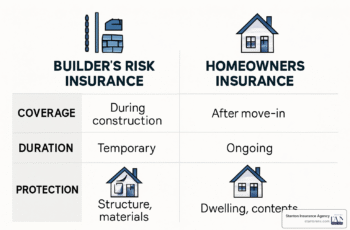Understanding Constraction Insurance: In the ever-evolving landscape of business and construction, managing risks is paramount. One crucial tool that businesses, particularly in the construction industry, utilize to safeguard their financial interests is contraction insurance. This specialized insurance policy provides protection against various risks associated with construction projects, ensuring that contractors, developers, and stakeholders can navigate the complexities of construction with confidence.
This comprehensive guide explores everything you need to know about contraction insurance, from its definition and types to its benefits, coverage options, and how to choose the right policy. Whether you are a contractor, project manager, or investor, understanding contraction insurance can significantly impact the success and security of your construction endeavors.
What is Contraction Insurance?
Contraction insurance, often referred to as construction insurance, is a type of insurance designed to protect parties involved in construction projects from potential financial losses resulting from unforeseen events. These events can include property damage, accidents, injuries, theft, or delays that might occur during the construction process.

The primary purpose of contraction insurance is to mitigate risks that could otherwise lead to substantial financial burdens or legal liabilities. It acts as a safety net, ensuring that construction projects can proceed without the constant threat of catastrophic losses.
Why is Contraction Insurance Important?
Construction projects are inherently risky due to their complexity, the involvement of multiple parties, and exposure to various hazards. Here are several reasons why contraction insurance is essential:
- Risk Mitigation: Construction sites are prone to accidents, natural disasters, theft, and damage. Insurance helps mitigate these risks.
- Legal Compliance: Many jurisdictions require contractors to carry specific types of insurance to obtain permits and licenses.
- Financial Protection: Insurance safeguards against unexpected costs that could derail a project’s budget.
- Peace of Mind: Knowing that risks are covered allows contractors and developers to focus on completing the project efficiently.
- Client Confidence: Clients and investors are more likely to trust contractors who have adequate insurance coverage.
Types of Contraction Insurance
Contraction insurance is not a one-size-fits-all policy. It encompasses various types of coverage tailored to different aspects of construction projects. Here are the most common types:
1. Contractor’s All Risks (CAR) Insurance
CAR insurance is a comprehensive policy that covers physical damage to the construction project, including materials, equipment, and temporary structures. It protects against risks like fire, theft, vandalism, and natural disasters.
2. Public Liability Insurance
This insurance protects contractors against claims made by third parties for bodily injury or property damage caused during the construction process. It is crucial for covering legal liabilities arising from accidents affecting the public or neighbors.
3. Employer’s Liability Insurance
If the contractor employs workers, this insurance covers claims related to work-related injuries or illnesses suffered by employees during the project.
4. Professional Indemnity Insurance
For contractors offering design or consultancy services, professional indemnity insurance covers claims arising from negligence, errors, or omissions in their professional duties.
5. Equipment and Machinery Insurance
This covers construction equipment and machinery against damage or theft, ensuring that essential tools remain operational throughout the project.
6. Delay in Start-Up Insurance
Also known as advanced loss of profits insurance, this policy covers financial losses due to delays in project completion caused by insured events.
Key Coverage Areas in Contraction Insurance
Understanding what contraction insurance covers is essential for selecting the right policy. Typical coverage areas include:
- Property Damage: Damage to the construction site, materials, equipment, and temporary structures.
- Third-Party Injury or Damage: Coverage for injuries or damage caused to third parties during construction activities.
- Employee Injuries: Protection against employee injuries or illnesses related to the construction work.
- Legal Expenses: Coverage for legal costs arising from claims or disputes.
- Delay Costs: Financial losses due to project delays resulting from insured perils.
- Theft and Vandalism: Protection against loss or damage caused by theft or vandalism.
How to Choose the Right Contraction Insurance Policy
Selecting the appropriate contraction insurance policy involves careful consideration of various factors:
Assess Your Risks
Evaluate the specific risks associated with your construction project, including location, scope, materials, and workforce.
Understand Coverage Needs
Determine which types of coverage are essential for your project. For example, if you use heavy machinery, equipment insurance might be necessary.
Compare Policies
Request quotes from multiple insurers and compare coverage limits, exclusions, premiums, and claim procedures.
Review Policy Exclusions
Be aware of what is not covered by the policy to avoid surprises during a claim.
Consult Experts
Seek advice from insurance brokers or legal professionals specializing in construction insurance.
Check Insurer Reputation
Choose insurers with a strong track record in handling construction claims efficiently.
Common Exclusions in Contraction Insurance
While contraction insurance offers broad protection, certain exclusions commonly apply:
- Wear and tear or gradual deterioration of equipment.
- Faulty design, workmanship, or materials.
- War, nuclear hazards, and terrorism.
- Uninsured delays not caused by covered perils.
- Contractual liabilities beyond the scope of the policy.
Understanding these exclusions helps in negotiating better terms or purchasing additional coverage if needed.
The Claims Process for Contraction Insurance
Filing a claim under contraction insurance involves several steps:
- Immediate Notification: Inform the insurer promptly after an incident.
- Documentation: Provide detailed documentation, including photos, reports, and evidence of loss or damage.
- Assessment: The insurer will assess the claim, often involving site inspections.
- Resolution: Upon approval, the insurer compensates for covered losses according to the policy terms.
- Dispute Handling: If disputes arise, mediation or legal recourse may be necessary.
Timely and accurate communication during the claims process is vital to ensure smooth settlement.
Benefits of Contraction Insurance
- Financial Security: Protects investment and prevents unexpected financial strain.
- Enhances Credibility: Demonstrates professionalism and responsibility to clients and partners.
- Compliance: Meets legal and contractual insurance requirements.
- Risk Management: Allows better planning and risk allocation.
- Business Continuity: Helps maintain operations despite accidents or setbacks.
Case Studies: Real-World Examples
Case Study 1: Fire Damage on a Construction Site
A major fire broke out due to an electrical fault, destroying materials and partially damaging the structure. Thanks to CAR insurance, the contractor received compensation that covered the costs of rebuilding and replacing materials, allowing the project to continue without significant financial loss.
Case Study 2: Third-Party Injury Claim
During excavation, a passerby was injured due to falling debris. Public liability insurance covered the medical expenses and legal fees, protecting the contractor from direct liability and expensive lawsuits.
Case Study 3: Equipment Theft
A valuable crane was stolen from the site overnight. Equipment insurance reimbursed the loss, enabling the contractor to replace the machinery and avoid project delays.
Tips for Contractors to Maximize Insurance Benefits
- Keep comprehensive records of all project activities.
- Conduct regular safety training for workers.
- Maintain equipment properly to avoid unnecessary claims.
- Understand policy terms and maintain open communication with insurers.
- Review and update insurance policies as projects evolve.
Future Trends in Contraction Insurance
The construction industry is witnessing technological and regulatory changes that influence contraction insurance:
- Digital Risk Assessment: Use of AI and data analytics to better evaluate construction risks.
- Sustainability Focus: Insurance policies adapting to environmentally friendly building practices.
- Modular Construction: New coverage models for prefabricated and modular building methods.
- Cybersecurity: Emerging coverage for cyber risks related to construction technology.
- Integrated Risk Management: Collaboration between insurers, contractors, and regulators for holistic risk solutions.
Conclusion
Contraction insurance is an indispensable tool for managing the complex risks inherent in construction projects. By providing financial protection, legal coverage, and peace of mind, it enables contractors and developers to focus on delivering successful projects on time and within budget.
Understanding the types of contraction insurance, coverage options, policy selection, and claims process empowers construction professionals to make informed decisions that safeguard their investments and reputations. As the construction industry continues to innovate and evolve, staying updated on insurance trends and best practices will remain critical to long-term success.
Investing in the right contraction insurance policy is not just a regulatory formality but a strategic move that underpins resilience and growth in the dynamic world of construction.


